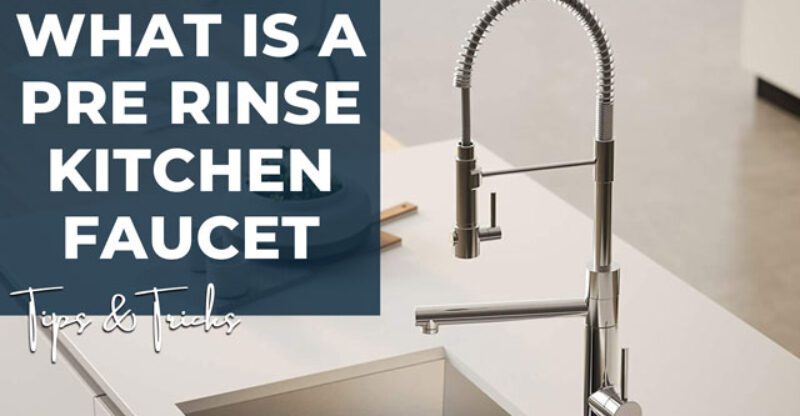What Is A Pre Rinse Kitchen Faucet – Essential Guide
Your kitchen faucet is an essential part of your kitchen, and it comes in a wide variety of options that can be confusing to sort through. Pre-rinse kitchen faucets are incredibly popular these days, and they’re quickly becoming the standard in many kitchens. That’s because they allow you to wash your dishes before you fill up the sink, streamlining the washing process significantly so you can get more dishes done in less time.
One of the most popular options, though, is called the pre-rinse kitchen faucet, which can serve multiple purposes in your kitchen while saving you time and energy overall. To find out more about pre-rinse kitchen faucets, including how they work and what they can do for you, read on.
What is a Pre Rinse Kitchen Faucet & How Does it Works
As the name implies, pre-rinse kitchen faucets are used to rinse foods and other items before they go into the dishwasher.
A pre-rinse kitchen faucet is a type of faucet that has a detachable spray head. This allows you to easily rinse off dishes and cookware before putting them in the dishwasher. Plus, it can make cleaning your sink a breeze.
Here’s how it works First, detach the sprayer from the faucet. Fill up your sink with warm water so it reaches the top of the bowl. Place the dished face down into this water and use a brush or sponge to scrub away any food particles on them (including things like a baked-on egg). When they’re clean, lift them out of the water and place them on an elevated surface (like a drying rack) while they air dry. Reattach the sprayer to the faucet and turn the water back on. After rinsing off all of your dishes and placing them in your dishwasher, turn off the tap. That’s all there is to it.
Pre-Rinse vs Pull Down Faucets: Which is Right for Your Kitchen?
Pre-rinse and pull-down faucets are two of the most common types of kitchen faucets, but many homeowners aren’t sure which one they need or what the difference between them is. This guide will go over the differences in these faucet types so you can figure out which one you need and why you should invest in it.
Pre-rinse sinks are designed to make it easy to rinse off dishes before putting them in the dishwasher. They typically have a high arc spout that can be adjusted to different angles, making it easy to reach all areas of the sink. Pre-rinse faucets also usually have a sprayer attachment that can be used for spot cleaning or rinsing larger items.
In addition, pre-rinse faucets also have a second lever on the handle. When it’s turned on, water will flow through an additional filter before coming out of the nozzle. This makes them perfect for those who want cleaner water coming out of their taps without having to install separate filtration systems in their home.
Pull-down faucets are a type of kitchen faucet that has a spray head that can be pulled down from the spout. This allows you to wash large pots and pans more easily, or even your sink itself. Plus, many pull-down faucets come with a pause button, so you can avoid making a mess when filling up containers.
Pre-Rinse Kitchen Faucets: Pros and Cons
Pros:
- With a pre-rinse faucet, you’ll have greater control over the water pressure and temperature, making it easier to rinse off dishes before putting them in the dishwasher.
- These models often come with a detachable sprayer hose, giving you even more flexibility when cleaning up.
- They also tend to include an option for intermittent spray or a continuous stream, so you can choose what type of flow best suits your needs.
- They’re very durable and built to last.
Cons:
Pre-rinse kitchen faucets are a great addition to any kitchen, but there are a few things you should know before you buy one.
- Pre-rinse faucets are more expensive than standard models.
- They require more maintenance and care.
- In terms of installation, most people find that pull-down faucets are easier to install than pre-rinse sinks.
- The water pressure from a pre-rinse faucet can be too much for some plumbing systems.
- Pre-rinse faucets can be harder to find parts for if something goes wrong.
Must-Know Features of Pre-Rinse Kitchen Faucets
You’ve done your research, and you know that your next kitchen faucet needs to be a pre-rinse model. What now? To help you weed through all the options, here are 10 must-have features to look for when buying a pre-rinse kitchen faucet.
Style & Material
One of the first things you’ll want to consider when shopping for a pre-rinse kitchen faucet is the style. Do you want a traditional look, or something more modern? What about the finish? Stainless steel is always popular, but you might also consider oil-rubbed bronze or even brushed nickel.
Flexibility
When it comes to pre-rinse kitchen faucets, flexibility is key. You want a faucet that can be adjusted to fit your specific needs. Consider things like the height of the faucet, the angle of the spray head, and the reach of the hose. Also, make sure the faucet you choose is easy to install and use.
Water Efficiency
Nowadays, many people are looking for ways to be more water efficient in their homes. A pre-rinse kitchen faucet can be a great way to save water when doing the dishes. The USA survey shows that homeowners who invest or planned to invest in high-tech kitchen faucets in 2022. The survey result shows that 24% of the homeowner were planning to choose water-efficient faucets.
Temperature Settings
When looking at pre-rinse kitchen faucets, one of the things you’ll want to consider is the temperature settings. Generally, most faucets have two settings: hot and cold, but some may also have a third setting, normally labeled warm. This can be helpful if you find that the water is too hot or too cold for your needs. You’ll also want to consider how easy it is to adjust the temperature.
Warranty and Maintenance Requirements
When looking at pre-rinse kitchen faucets, be sure to check the warranty and maintenance requirements. Most manufacturers offer a limited warranty, so it’s important to know what’s covered and for how long. Maintenance requirements will vary depending on the model, but generally speaking, you’ll need to regularly clean and lubricate the moving parts. Pay attention to these details before making your purchase to avoid any headaches down the road.
Wash Performance
One of the most important things to consider when buying a pre-rinse kitchen faucet is wash performance. You’ll want to make sure that the faucet you choose can handle the number of dishes you’ll be washing daily. Additionally, you’ll want to consider the spray pressure and water flow rate. The higher the pressure and flow rate, the better your faucet will be at getting those tough, stuck-on food particles off your dishes.
Water Pressure & Purification
One of the most important things to consider when buying a pre-rinse kitchen faucet is the water pressure. You want to make sure that the faucet you choose can provide enough water pressure to efficiently rinse your dishes. Additionally, you’ll want to consider the quality of the water that will be coming out of the faucet. If you’re concerned about impurities in your water, look for a faucet with a built-in water purification system.
Anti-Bacterial Seals
An antibacterial seal will help keep your sink and countertop clean and free of harmful bacteria. You should also look for a faucet that has a built-in soap dispenser. This will make it easy to keep your hands clean while you’re cooking. Another feature to look for is a detachable spray head.
How Much Will It Cost To Install A Pre-Rinse Kitchen Faucet
Faucets can range in price from around $25 to $3,000. The type of faucet you choose will impact the cost. For example, a basic faucet may cost around $25 while a more luxurious option could cost up to $3,000. The installation process will also add to the overall cost.
Pre-rinse kitchen faucets typically start at around $100. It takes between two and three hours for an experienced professional to install one, which costs around $150-$400 according to a home advisor.
However, many factors affect the total cost of installing a pre-rinse kitchen faucet. This includes the kind of sink installed and if any existing fixtures need to be removed or replaced.
The average cost of the installation starts at about $225 considering all these things. If a plumber charges by the hour, this could increase to about $400+. Installation prices vary depending on location as well so it’s best to call around and get quotes before deciding who you want to work with.
Conclusion
Pre-rinse kitchen faucets are becoming increasingly popular in home kitchens. This faucet is designed to make the pre-rinsing of dishes easy and more efficient. You can save time and water when washing dishes by installing a pre-rinse kitchen faucet.
FAQs
A pre-rinse kitchen faucet is water efficient and saves time. It would help in preventing sink and clean water residue with its self-cleaning functionality.
Here are some tips on how to fix a pre-rinse faucet:
1. Take the handle off and unscrew the packing nut that attaches it to the stem.
2. Lift out the stem assembly and inspect it carefully.
3. If you find gunk built up around where it meets with the packing nut, use needle nose pliers or a screwdriver to remove this gunk by turning it counterclockwise with your fingers until it comes free.
4. After removing all traces of gunk from around this area, reattach the stem assembly using the fresh Teflon packing material.
The main difference between a bar sink and a kitchen sink is that a bar sink is smaller. A typical bar sink is about 15 inches wide, while a kitchen sink is about 22 inches wide. The smaller size of a bar sink makes it more convenient for cleaning glasses and other small items. Another difference between a bar sink and a kitchen sink is that a bar sink has a lower profile. This means that the basin of the sink sits lower on the countertop, making it easier to reach over and rinse things off.
The answer is yes, different brands on the market provide different quality at different price variations. It all depends on what your needs and preferences are when selecting a pre-rinse kitchen faucet.



